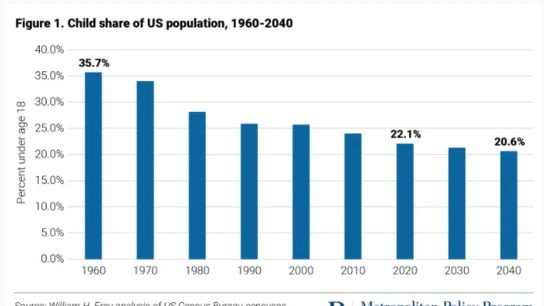There I was, doing some light reading on coming demographic changes to the United States, when I came across a map that stopped me in my tracks.
In his report on the issue, William H. Frey, a senior fellow for the non-partisan Brookings Institute's metropolitan policy program, compiled this map showcasing increases or declines to the child population in each state.
Note that these rises or declines are not represented as a share of the total population, but as the raw numbers of persons aged between 0 and 17. Frey finds 30 states registered "absolute declines" in their child populations during the decade of 2010 to 19.
As you can see, every Big Ten state save for Minnesota and Nebraska registered a decline, most of them large ones. In fact, every state east of the Mississippi River registered a decline save for Florida, Tennessee and the southern Atlantic seaboard.
While California, which is suffering from its own negative migration, registered a modest decline, every other Western state save New Mexico and Wyoming grew their child populations.
Clicking over to the Brookings site allows you to scroll over each state.
These states registered the largest increases:
1. North Dakota -- a whopping 20.2%
2. Texas -- 7.8%
3. South Dakota -- 7.1%
4. Utah -- 6.9%
5. Florida -- 5.7%
And these states endured the largest decreases:
1. Vermont -- 11.8%
2. New Hampshire -- 11.1%
3. Connecticut -- 11.0%
4. Illinois -- 9.9%
5. Maine -- 9.4%
You'll note the largest declines came in the Northeast, but this is a college football website, so that deep magenta stretching across Pennsylvania, Ohio, Michigan, Wisconsin and Illinois is what caught my eye.
If there's a silver lining here, it's that a falling child population isn't exactly a new phenomenon. In fact, the share of young people in America has been on a steady decline since the Baby Boom peak of 1960.

"In the decades to come, children will be a far rarer demographic commodity than they were in the nation’s past," Frey writes. "This is why they need to be nurtured. Not only are they America’s future, but the youth will become an important asset to our future labor force, which will be tasked with supporting an increasingly large retiree population."
Sure, nurturing the next generation so they can support an aging cohort of retirees is important, but tracking an expected rise or fall in high school football participation numbers is what really matters. Right, folks?
